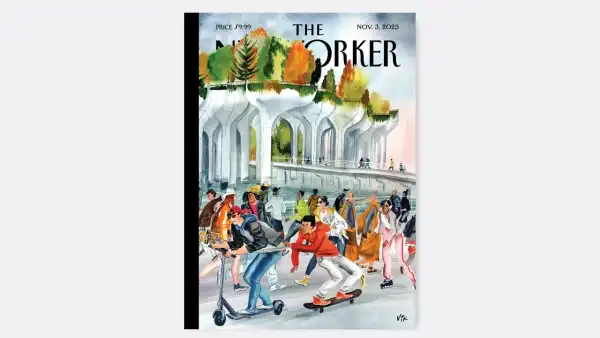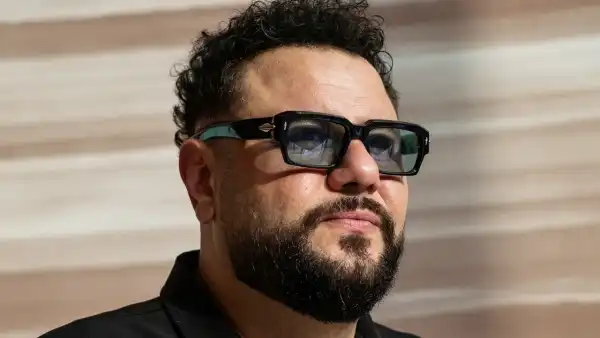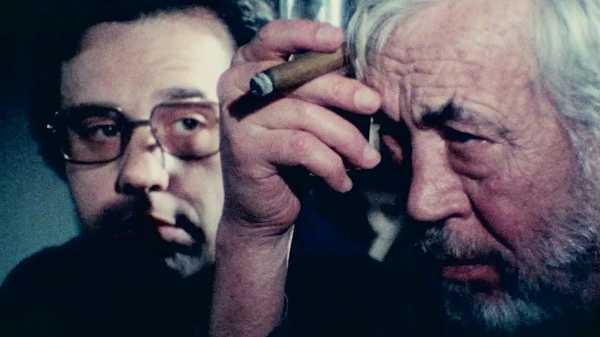
In 1937, Orson Welles had a strange run-in with Ernest Hemingway. The future director of “Citizen Kane,” who was then twenty-two, was recording voice-over for the documentary “The Spanish Earth,” a Spanish Civil War film for which Hemingway and John Dos Passos had supplied a text. When Welles proposed some changes, Hemingway rasped, “Some damn faggot who runs an art theatre thinks he can tell me how to write narration.” Welles responded by assuming a fey voice and saying, “Oh, Mr. Hemingway, how strong you are and how big you are!” A physical altercation ensued. Then the two men burst out laughing, and got drunk. Or so Welles claimed.
The incident lingered in Welles’s mind. He was probably aware of the sexual ambiguities that lay behind Hemingway’s macho façade. In the nineteen-sixties, Welles wrote a script entitled “The Sacred Beasts,” about a movie director who attends bullfights and becomes enchanted by a charismatic toreador. In a subsequent script, titled “The Other Side of the Wind,” the bullfighter becomes a young actor, whom the director, Jake Hannaford, has discovered, tormented, and driven away. The main action takes place at Hannaford’s seventieth-birthday party, where portions of his latest picture, a cryptic exercise in art-house psychedelia, are being screened. Hannaford drinks himself into oblivion and dies the next morning in a car crash. Welles shot the script in stages between 1970 and 1976, with John Huston in the principal role. About forty minutes of film had been edited when the project became hopelessly mired in financial and legal difficulties. It was unfinished at the time of Welles’s death, in 1985.
In the following decades, Welles obsessives, of whom I am one, experienced fleeting excitement whenever plans to release “The Other Side of the Wind” were announced, only to see the prospect slip back into limbo. In 2014, the Times reported that an agreement had been reached with various rights-holders, who included Welles’s daughter Beatrice; his companion, Oja Kodar; and the estate of the brother-in-law of the Shah of Iran. A year later, that effort, too, seemed to have stalled, and recriminations were flying on Welles fan sites. Fortunately, the streaming behemoth Netflix had quietly taken an interest, and the company’s resources lifted whatever curse had impeded Welles’s most ambitious late-period undertaking. On September 29th, “Wind” will play at the New York Film Festival, and, on November 2nd, forty-eight years after filming began, it will open in theatres and appear on Netflix.
Over the past year and a half, I have been observing while a team led by the director Peter Bogdanovich, the producers Frank Marshall and Filip Jan Rymsza, and the editor Bob Murawski have worked their way through Welles’s material and tried to surmise what this most unpredictable of auteurs would have wanted. Welles buffs will long argue over their choices, but the film is a major addition to the director’s canon, offering a sometimes harrowingly personal vision. Hannaford is hardly a self-portrait, but his predicament is not unlike Welles’s own: he is a legend whose past overshadows his present. At the same time, “Wind” is an exhilarating forward leap, its rapid-fire editing and pseudo-documentary format heralding modern styles. Ultimately, it has the Wellesian quality of not caring what you make of it. As one of Hannaford’s minions says, bringing out a stack of film cans, “Well, here it is, if anybody wants to see it.”
When Welles fans discuss the fate of “Wind,” the name Oja Kodar inevitably surfaces, often in an unflattering light. A Croatian sculptor and actress, she co-wrote the script, had a lead role in the film, and—as the Welles scholar Jonathan Rosenbaum has established—directed three scenes of the film-within-the-film. She has been accused of holding up efforts to complete it, whether because of excessive demands or on account of a psychological block against seeing it finished. Yet she has artistic as well as legal authority over the work. In 2015, she made a rare public appearance at a Welles festival in Woodstock, Illinois. (The town was formerly the site of the Todd School for Boys, where Welles’s theatrical career began.) In an interview with Rosenbaum, Kodar made clear her profound attachment to “Wind.” Now in her late seventies, she is a charismatic woman who speaks in a mixture of poetic flights and pungent aphorisms.
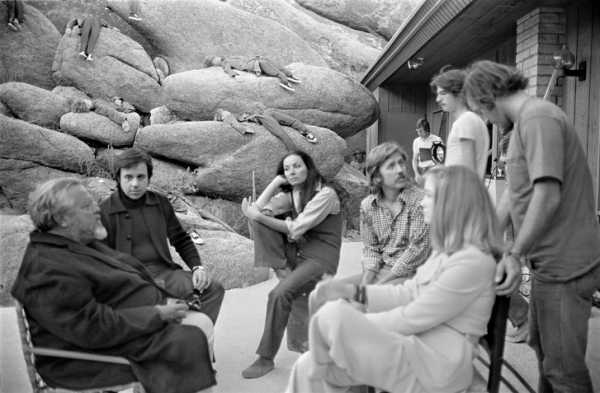
Orson Welles with actors on the set of “The Other Side of the Wind.”
Photograph by José María Castellví / Netflix
She was born Olga Palinkaš, of Hungarian and Croatian parentage. Welles met her in 1961, when he went to Croatia to shoot his version of Kafka’s “The Trial.” He named her his “present from God,” and persuaded her to change her name; “Ko dar” is Croatian for “as a present.” She, in turn, coined the title of Welles’s final major film. In Woodstock, she told the story: “We walked in Cinecittà, which is a big Roman movie studio, and there was a set from ‘Romeo and Juliet’ from Zeffirelli, and the day was very, very windy, and Orson had on him his big black cape, and the wind went under that cape and opened it, and he looked like a giant bat.” She went on to say, “He was more than human. He was an element of nature, he was wind.”
Kodar had written a story about a director who sleeps with his male stars’ girlfriends as a way of indirectly sleeping with the actors themselves. This neatly meshed with Welles’s scenario of the secret desires of a macho auteur. Jake Hannaford’s work-in-progress, which is ostensibly a parody of contemporaneous European films like Antonioni’s “Zabriskie Point,” depicts a sexual tryst between Kodar’s character, a Native American radical, and a shaggy-haired Jim Morrison lookalike. “Wind” also includes outtakes in which Hannaford is heard mocking his blank-eyed star, who is named John Dale. (The Canadian actor Robert Random played the role; Welles had seen him on “Gunsmoke.”) Characters around Hannaford speculate on the nature of his relationship with Dale, which seems to combine erotic fascination and sadistic manipulation.
Later, I asked Kodar about Welles’s predilection for such themes. “In terms of the eroticism,” she said, “I think that it was my fault that he got into that.” But, she added, Welles sympathized with gay people and understood their predicament in the pre-liberation days. In an agonizing scene toward the end of “Wind,” Hannaford taunts an elderly, effete man who had once been John Dale’s schoolteacher. Huston’s snarling delivery of the word “faggot” harks back to Welles’s encounter with Hemingway. Huston’s grizzled charm has dominated the movie thus far—“He was the sexiest old devil I’ve ever seen,” Kodar told Rosenbaum—but Hannaford now reveals himself as a monster, a destroyer. At the end, he is heard saying, on tape: “You shoot the great places and the pretty people—all those girls and boys. . . . Shoot ’em dead.”
Until last year, no one knew how much of “Wind” there was and whether it amounted to a real movie. The negative had been sitting in vaults and labs in and around Paris, and, because of legal entanglements, very few people had examined it. In March, 2017, after Kodar signed off on the Netflix deal, more than a thousand reels of film, comprising nearly a hundred hours of footage, were shipped to Los Angeles. The labels on the cans followed an esoteric naming system that took time to unravel. Some were clear enough: “Lights Out” was the scene in which a power outage at Hannaford’s party stops the projection of his movie. “Midget Talk” was more obscure. “Wagonmaster” stumped everyone, until it was noticed that a poster for the John Ford film of that title could be seen hanging on a wall. Most of the lettering was in Welles’s block-letter hand. One could almost hear his voice booming from the storeroom shelves.
Early on, I spoke to Bogdanovich, Marshall, and Rymsza about their relationship with Welles and “Wind.” The first two had been part of the saga from the outset. Bogdanovich met Welles in 1969, when he was twenty-nine. Just as “Wind” got under way, he directed “The Last Picture Show,” which caused him to be described as the second coming of Orson Welles. As the “Wind” shoot dragged on, Bogdanovich took the role of a young director named Brooks Otterlake, who has begun to overshadow Hannaford, his mentor. Bogdanovich, now seventy-nine, a master director who has survived his own reversals and tragedies, recalls his Welles period with a certain bittersweet nostalgia. An expert mimic, he recounted a favorite moment on the shoot. Huston asked, in his golden growl, “And how many films have you acted in, Peter?” Bogdanovich answered, “One.” Huston said, “That’s not very many?” Bogdanovich then mimed Welles guffawing in the background, “Not very many! Bwah ha ha! Not very many!”
Marshall, a Hollywood heavyweight, has produced “Raiders of the Lost Ark,” “Back to the Future,” “The Bourne Identity,” and a dozen other blockbusters. Later this year, he and his wife, the producer Kathleen Kennedy, will receive the Irving G. Thalberg Memorial Award. He got his start working for Bogdanovich in the late sixties, when he was in college; he joined “Wind” in 1971, as a production manager. “I was running around trying to do whatever Orson wanted,” Marshall told me. “I was fired frequently. I’d wait until he said, ‘Where’s Frank? Get Frank!’—as if I’d somehow just wandered off.” Ryan Suffern’s documentary featurette “A Final Cut for Orson,” which Netflix is releasing with “Wind,” includes an outtake in which Marshall’s head pops into the frame, causing Welles to bellow, “That shot was rendered useless by Frank!”
Rymsza is the newcomer. A soft-spoken forty-year-old with side-swept bangs and a trimmed beard, he was born in Poland but came to America with his family in the mid-nineteen-eighties, after the imposition of martial law in his home country. Rymsza studied economics and philosophy at the University of Chicago before turning to film, working variously as a writer, director, and producer. He learned of “Wind” around 2009, and began plotting to win rights to the negative. Although he didn’t begin as a Welles devotee—he was oriented more toward European, Russian, and New Asian cinema—Rymsza acquired an encyclopedic knowledge of the “Wind” material, combing boxes of scripts and memos that are stored in the Welles archive at the University of Michigan. “This was more about my love of cinema than my love of Welles,” Rymsza says. A degree of distance may have helped him to overcome the obstacles that foiled previous attempts.
In June of last year, I joined Rymsza on a visit to a production facility in Burbank, where the negative was being cut, in preparation for scanning and editing. In the digital era, negative cutting has gone into decline, but for those directors who still shoot on film—or for anyone making a restoration—expertise in the field is vital. Mo Henry, a member of a multigenerational family of cutters, is regarded as the master of the art. Her first feature was “Jaws,” in 1974. She recalled, “Everyone thought it was going to be crap, so they let me work on it. My dad said, ‘It looks like it’s going straight to TV.’ ”
Henry showed me a strip of 16-mm. film, in which Bogdanovich is seen riding in a car with Huston. “What sets this apart from almost everything I’ve done,” she told me, “is that it uses all these different kinds of stock: thirty-five, sixteen, Super 8, sometimes color, sometimes black and white. The idea is that everything we’re seeing is footage from Hannaford’s movie or from media people following him around.” Early on, she was looking at a take when she saw a familiar face holding the slate: Welles himself. In the late seventies, she had met Welles at Ma Maison, his favorite restaurant. “He was very intimidating, with his theatrical presence,” Henry told me. “I said about ten words.”
She turned to Rymsza and asked, “Did you ever find out why Orson used reversal film?” Rymsza shook his head. Reversal film produces a positive rather than negative image: when you look at a piece of footage, you see what is projected. Colors tend to be bolder and less subtle. Reversal film was a cheaper process, but Rymsza suspected that Welles also had an artistic reason. “Someone told me that reversal was used in a lot of documentaries,” Rymsza said to Henry. This may have been the look that Welles wanted: raw footage of live events.
The shooting process for “Wind” was sufficiently convoluted and melodramatic that it has yielded not only a behind-the-scenes book—Josh Karp’s “Orson Welles’s Last Movie,” which was published in 2015—but also a full-length documentary, Morgan Neville’s “They’ll Love Me When I’m Dead,” which is another part of Netflix’s Welles package. These narratives give the impression of a carnivalesque production that was perhaps doomed to failure from the outset. Yet Welles was in steady pursuit of a daring conceit: a film as much improvised as scripted, reflecting the circumstances in which it gestated, a heightened version of Hollywood reality.
The first day of shooting took place in August, 1970. Although Welles had not yet cast Huston, he wished to film a scene in which cinéastes are badgering Hannaford. (In his later work, Welles often assembled scenes from shots obtained in different places and at different times.) Bogdanovich played an obnoxious journalist, squawking in a Jerry Lewis voice; the young movie critic Joseph McBride portrayed a pretentious academic. They asked questions like, “Is the camera a reflection of reality, or is reality a reflection of the camera eye? Or is the camera a phallus?” None of this was used in the final film, since Bogdanovich later switched to the role of Otterlake, but choice moments can be seen in Neville’s lively documentary.
The escapades went on for years. Welles rented a house in Carefree, Arizona, to shoot the party scenes. Everyone who walked into his life seemed to get a cameo. The directors Paul Mazursky, Henry Jaglom, Curtis Harrington, and Claude Chabrol appear as themselves, arguing about the state of film. Dennis Hopper jabbers about whatever. The great old vaudevillian George Jessel toasts Hannaford as “the Ernest Hemingway of the cinema, the Murnau of the American motion picture. Who Murnau is, I don’t remember.” Susan Strasberg plays an acidulous critic à la Pauline Kael: “What he creates, he has to wreck, it’s a compulsion.” (Kael’s article “Raising Kane,” which appeared in The New Yorker in 1971, incensed Welles to no end.) Lilli Palmer is a saturnine icon in the Marlene Dietrich mold. Longtime Welles associates like Mercedes McCambridge and Paul Stewart deliver wisecracks. Especially fine is Tonio Selwart’s sly, stylish turn as a Hungarian émigré known only as the Baron. “I’d call him a necromancer,” the Baron says of Hannaford. “But I do not know if he has raised the dead.”
By 1975, Welles had commenced work on the editing. He showed two scenes at a 1975 American Film Institute tribute to his work, hoping to raise end money. The first was a kaleidoscopic party sequence, studded with Huston one-liners: “It’s all right to borrow from each other—what we must never do is borrow from ourselves.” This got a good response. But the second scene fell flat. Hannaford’s right-hand man, Billy—the director Norman Foster, in a touching performance as a crumbling stooge—is showing fragments from the work-in-progress to a suave studio executive named Max David, who very much resembles Robert Evans, the head of Paramount at the time. For the celebrity crowd, this probably hit too close to home. David becomes exasperated at the oblique imagery on screen, and the following exchange occurs:
MAX: I’d better read a script.
(pause) There isn’t one.
(another pause) Jake is just making it up as he goes along.
BILLY (weakly): He’s done it before.
This elicited nervous laughter in 1975, and receives the same response today. It appears to be a kind of confession on Welles’s part. The irony is that there was a script, which in this instance the actors were reciting word for word. Despite the improvisatory trappings, “Wind” was a tightly configured story with a beginning, a middle, and a very dark end.
More money was not forthcoming, and “Wind” descended into the quagmire where it would be trapped for so long. Welles had signed a production agreement with the French-based company Les Films d’Astrophore, which was owned by Mehdi Boushehri, the brother-in-law of Shah Reza Pahlavi. By 1976, Welles was locked in a dispute with Astrophore. In later years, he liked to say that the Iranian Revolution of 1979 had prevented the completion of the picture, but, as Karp makes clear, Welles had spoiled various chances for a resolution by dithering or changing his demands. The popular image of Welles as a reckless, irresponsible artist is a canard; his reputation for catastrophically poor business decisions is well grounded.
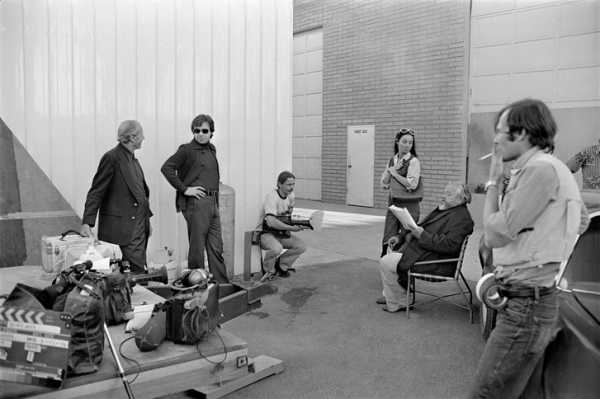
Orson Welles with actors and crew members on the set of “The Other Side of the Wind.”
Photograph by José María Castellví / Netflix
By December of 2017, “Wind” had inched past the stage at which Welles had left it. Murawski, an incisive film editor who won an Oscar for “The Hurt Locker,” had made his way through most of the footage. When I visited the editing room, at Tribeca West, in West Los Angeles, Murawski had cued up a frame from Hannaford’s movie—a shot of John Dale riding a motorcycle through an empty parking lot, with street lights glowing in blue mist. “Looks amazing, doesn’t it?” Murawski said. “It’s a testament to the durability of film. This has been sitting around for forty years, and so much of it looks great right out of the can.”
Murawski, a cult-film enthusiast who has led many restoration projects, is a longtime Welles admirer; “The Trial” is his favorite item in the canon. Although he is too young to have met the director—he is fifty-four—he knew the cinematographer Gary Graver, who worked with Welles from 1970 onward, and who valiantly tried to finish “Wind” until his own death, in 2006. “One big revelation of this will be just how good Gary was,” Murawski said. “He had a reputation as this low-budget guy who did Orson’s bidding, but images like these”—he gestured toward the monitor—“are breathtaking.”
We looked at three scenes from different parts of the movie. The first essentially replicated Welles’s edited version of the party sequence, although the style was a bit less splintered and frenetic. “Welles tailored that scene for the A.F.I. event,” Murawski said. “He might have changed his mind later. My job is to make this smooth enough to be presentable, but not so smooth that it becomes a conventional narrative movie.” The second scene consisted of dialogue between Huston and Bogdanovich—strongly contrasted black-and-white footage, reminiscent of “Touch of Evil.” This looked splendid but was fairly atrocious in terms of sound quality. “That’s one for Scott and Daniel to figure out”—Scott Millan and Daniel Saxlid, the sound supervisors.
We then sampled a scene from the film-within-the-film. It showed John Dale and the nameless Oja Kodar character in a night club full of human grotesques, with luridly colored lampshades glowing out of deep shadow. “Look at those deep, deep contrasts,” Murawski said. “This is what we see Welles doing in his classic early work, but he’s found a way to do it in color. It’s noir in color.” It’s also an ironic homage to psychedelic films of the sixties, with multiple exposures, tilted angles, and flashes of nudity.
Rymsza, who had joined us, said, “This isn’t in any of the scripts. Orson probably never edited any of it. Bob just put it together over the weekend. It’s really important, because it sets up the big car-sex scene.” That sequence, a shockingly sensual vision of bodies writhing inside a car splashed with rain, has circulated widely on “Wind” bootlegs and can be seen in a documentary included with the Criterion Collection edition of Welles’s “F for Fake.”
Rymsza went on, “This gets into a bigger conversation that’s been active all along—how much of the film-within-the-film should we see? How long should it play?”
“Filip and I think this part should play uninterrupted,” Murawski said. “Peter and Frank have been a little more resistant: they want to stick to the ‘A’ story—Hannaford’s party. But I think the more Welles shot the Hannaford movie, the more he embraced it. There’s so much footage—he covered it to death. Oja Kodar was very involved, as well; she was into more experimental stuff. Orson probably had different ideas about how to approach it from day to day.”
Marshall and Bogdanovich had seen the night-club scene the previous day, and loved it. “Orson seemed like he was kidding around, making fun of the art-house stuff,” Bogdanovich later told me. “But he’s so good. He can’t help making it interesting.” The consensus was shifting toward using longer stretches of the Hannaford film, with occasional cutaways to people watching. In the final cut, this series of scenes—the club, a surreal bathroom orgy, and the car-sex sequence—lasts over eleven minutes, and it’s so absorbing that you begin to forget what you’re really watching. The destabilization of the narrative is a characteristic Wellesian effect: the parody becomes real; reality becomes a parody. Tellingly, the camera settles on Huston’s face when the male body is seen mostly naked: the Hemingway theme lingers.
Months of work remained. Kodar looked at a preliminary cut and asked for several adjustments. At her request, a shot of a rain-battered mill was added to the central sequence involving her character and John Dale. A panel of directors, including Rian Johnson, Quentin Tarantino, and Alexander Payne, offered notes. Michel Legrand, the eighty-six-year-old composer who had worked with Welles on “F for Fake,” wrote a score, alternating between light dance numbers for the party scenes and a florid, jazz-modernist style for the film-within-the-film. Mike Sowa and other digital-imaging specialists used the HDR process—High-Dynamic-Range Imaging—to maintain sharpness of contrast in the transfer from film to digital.
Millan and Saxlid, the sound editors, had perhaps the toughest job. While the negative was in generally pristine condition, the soundtrack was a mess, much of it available only in second- and third-hand transfers. Dialogue for several scenes was found on a Betacam tape that Sean Graver, Gary’s son, had in his garage. A few incomplete or distorted lines were fixed with sound-alike actors. One of these substitutes was spectacularly convincing: Danny Huston, the director’s son, can effortlessly fall into his father’s hoarse grandeur.
Saxlid, a wizardly Swede, spent more than three months cleaning up the dialogue, working seven days a week in a windowless room in Technicolor’s post-production facility on the Paramount lot. Multiple transfers of the soundtrack had caused a build-up of noise and distortion. He told me: “Usually, I apply an algorithm that distinguishes signal from noise, but here the signal was so weak that the program got confused.” Saxlid developed a secondary program, “a kind of forensics,” to expand microscopic portions of the track and reduce noise while preserving the voices. All this solitary activity gave him a curious sense of interaction with Welles himself. “So much of this we couldn’t have done even a few years ago. All these endless delays drove everyone crazy, but maybe the thing had to wait until we had all the right tools for it. I kept having a funny feeling that Welles had tossed all this to the future, for us to figure out.”
By late April, the “Wind” team was meeting at a Technicolor soundstage, reviewing each reel before locking it in place. They were a short walk from Stage 19, where Welles shot “Kane.” The day I was there, Marshall, Bogdanovich, Rymsza, Murawski, Millan, and Saxlid were joined by Ruth Hasty, the post-production supervisor, and Ellen Segal, the music editor. It was an eight-person attempt at approximating the mind of Orson Welles. Legrand’s score was in place, and questions arose about whether it had too pervasive a presence.
MARSHALL: I was wondering if the music in the first scene could be a
little lower. After all, they’ve walked away from the door here.
MURAWSKI: Yes, it should be not there at all, or quieter.
BOGDANOVICH: When the beads are cut, there’s a climax in the score,
which I think we should de-climax—it’s a little on the nose.
RYMSZA: When the Baron has his “necromancer” speech, I would cut out
the applause and the music. I like the starkness of it—sudden silence
while he delivers that line.
Knowing laughter in the room indicated that Rymsza was a fan of the Baron and was always pushing to highlight his appearances. “We all have our favorite characters,” Rymsza said to me.
On April 30th, the picture wrapped. The plan had been to have it ready for the Cannes Festival, in May; Welles had a long association with Cannes, and it seemed the perfect place for a posthumous première. But the saga would not have been complete without one last imbroglio: in mid-April, Netflix withdrew all its movies from Cannes after getting into a dispute with the festival. Instead, “Wind” had its début at the Venice Film Festival on August 31st, with a showing at the Telluride Film Festival the next day. Rymsza and Murawski went to Venice; Bogdanovich and Marshall were at Telluride. Amid the triumph, Bogdanovich sounded an unexpectedly melancholy note. “It’s not only Orson’s last movie, but it’s sort of like the end of everything,” he told the Telluride audience. “It comes across to me like the end of the world. It’s a very sad movie. Orson made a lot of sad movies, actually, but his artistry was the antidote. It’s almost as though he was saying that art was the only thing that can save us from the end.”
Nothing that Welles ever made, not even “Citizen Kane,” found universal acclaim, and “Wind” will be no exception. At Telluride, some in the crowd were underwhelmed. “All that work and it’s still a mess,” I heard someone say on the way out. On social media, there were suggestions that the film was hopelessly dated, that it was misogynist or homophobic, that it insulted Native Americans. (Kodar, as the Native radical, wears red makeup.) Others, though, found the piece unnervingly modern. Hannaford’s predatory nature is starkly on display; he paws at girls, leers at men, and calls Kodar “Pocahontas.” The movie refrains from taking a clear stance against its antihero. The most uncomfortable thing about the scene with John Dale’s schoolteacher is the way other men in the room smirk as Hannaford goes in for the kill.
All the while, “Wind” partakes of a typically Wellesian joy in darkness—a dance through disaster. As Hannaford spirals toward oblivion, his unfinished picture, which is an object of derision early on, becomes ever more potent: the final shots, of a beach swept by wind, are almost mystical in impact. The divergence of art and artist encapsulates Bogdanovich’s point about the double nature of Welles’s creation. But light breaks through in real life, too. During the power outage, John Carroll, a minor star of golden-age Hollywood, launches into Paul Lincke’s operetta number “The Glow-Worm,” waving a flashlight in time to the music. A crowd of young people sing along, serenading the camera and the magician behind it:
Shine, little glow-worm, glimmer, glimmer
Shine, little glow-worm, glimmer, glimmer
Lead us lest too far we wander
Love’s sweet voice is calling yonder . . .
If you listen closely, you might hear Welles in the mix, a bass line to the ragged, merry chorus.
Sourse: newyorker.com

